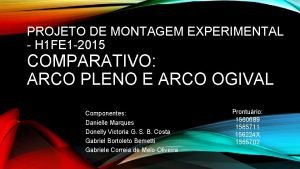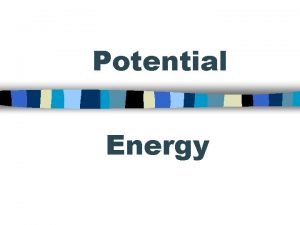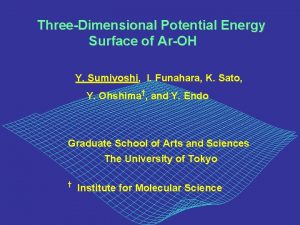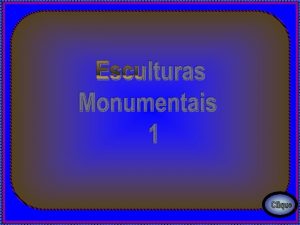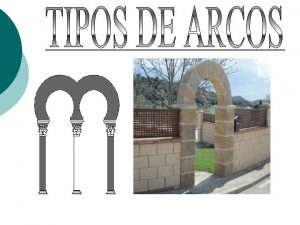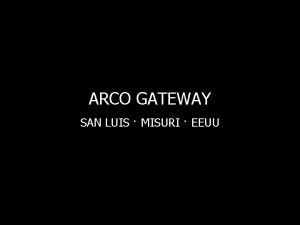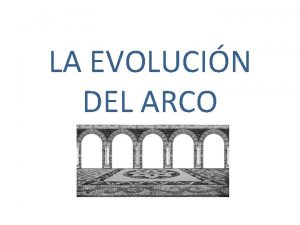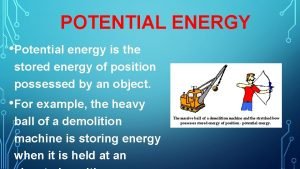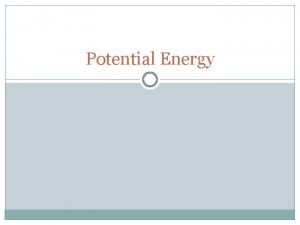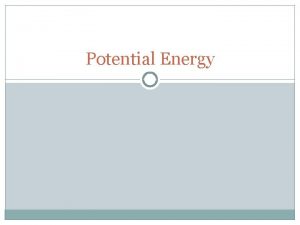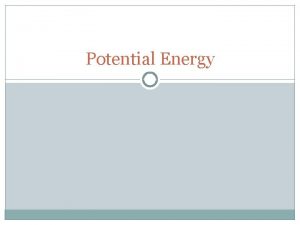The Threedimensional Potential Energy Surface of ArCO Yoshihiro
























- Slides: 24

The Three-dimensional Potential Energy Surface of Ar-CO Yoshihiro Sumiyoshi 1, Yasuki Endo 2 1. Faculty of Science and Technology, Gunma University 2. Graduate School of Arts and Sciences, University of Tokyo

Previous studies on Ar-CO MW & mm. W IR Ab initio T. Ogata, et al. , J. Chem. Phys. 98, 9399 (1993) W. Jaeger, et al. , J. Chem. Phys. 102, 3578 (1995) V. N. Markov, et al. , Rev. Sci. Inst. 69, 4061 (1998) M. Hepp, et al. , J. Mol. Spectrosc. 176, 58 (1996) M. Hepp, et al. , Mol. Phys. 92, 229 (1997) M. Hepp, et al. , J. Mol. Spectrosc. 183, 295 (1997) R. Gendriesch, et al. , J. Mol. Spectrosc. 196, 139 (1999) L. A. Surin, et al. , Rev. Sci. Inst. 72, 2535 (2001) D. G. Melnik, et al. , J. Chem. Phys. 114, 6100 (2001) A. R. W. Mc. Kellar, Y. Xu, et al. , S. Koenig, et al. , A. R. W. Mc. Kellar, I. Scheele, et al. , J. Mol. Spectrosc. 153, 475 (1992) Mol. Phys. 88, 859 (1996) Mol. Phys. 87, 1071 (1996) Mol. Phys. 91, 265 (1997) Mol. Phys. 98, 111 (2000) Mol. Phys. 99, 197 (2001) Mol. Phys. 99, 205 (2001) Mol. Phys. 101, 1423 (2003) R. R. Toczylowski , et al. , J. Chem. Phys. 112, 4604 (2000) CCSD(T) / aug-cc-p. VTZ T. B. Pederson, et al. , J. Chem. Phys. 117, 6562 (2002) CCSD(T) / aug-cc-p. VQZ

Previous studies on Ar-CO 2 D-IPES (fitting) L. H. Coudert, et al. , J. Chem. Phys. 121, 4691 (2004) M. Havenith and G. W. Schwaab, Z. Phys. Chem. 219, 1053 (2005) Attacking a Small Beast: Ar-CO, a Prototype for Intermolecular Forces “No satisfactory analysis has been carried out. ” Intermolecular potential energy surface (3 D-IPES) by directly fitting all available transition frequencies

Coupling Scheme C r G O q K R j L J G R r q : The center of mass of CO : Distance between G and Rg. : CO bond length. : Angle between R and r. Ar

Observed ro-vibrational levels MW & mm. W : ~ 200 lines IR : ~ 830 lines Energy / cm-1 80 60 40 (0, 6, 6)* (vvd. W, j, K) (3, 1, 0)* (0, 5, 5) (0, 4, 4) (0, 3, 2)* 20 0 (0, 3, 3) (0, 2, 2) (0, 1, 1)** (0, 0, 0)** (0, 2, 1) (0, 1, 0) (1, 2, 0)* (1, 1, 1)* (1, 0, 0) (vvd. W, j, K)** vco = 0, 1, 2

upper (v. CO, vvd. W, j, K) lower (v. CO, vvd. W, j, K) n 0 N weight Ar-12 CO mm. W: 5 * * IR: 25 Ar-13 CO * Pederson, et al. , J. J. Chem. Phys. 117, 6562 (2002)

Ab initio calculations An initial 3 -D potential by ab initio calculations CCSD(T) -F 12 b/ aug-cc-p. V 5 Z 2450 points R : 3. 3 ~ 15. 0 Å r : 1. 00 ~ 1. 35 Å q : 0 ~ 180 ° Molpro 2010. 1

Total Hamiltonian ~ 3 D analysis ~ Htotal = HAr. CO + HCO

Potential terms ~ 3 D IPES ~ Short range term Asymptotic term Legendre polynomial A total of 46 parameters are used to fit the ab initio potential surfaces s : 0. 32 cm-1

3 Dimensional Potential IR data 12 C /13 C r G’ G O q r’ q’ MW data R’ R Ar-12 CO Ar-13 CO Rg V(R, r, q ) 12 CO 13 CO r’ r V(R’, r’, q ’) 3 D potential surfaces

Eigenvalue calculation Total function: 1. Rotation: Rotation matrix jmax = 18 2. Vibration: anharmonic/harmonic oscillator vd. W stretching vibration vmax = 15/40 CO vibration vsmax = 7/35 Hamiltonian matrices to be diagonalized: ≈ 20000 Discrete variable representation(DVR)

Least-squares fitting Direct fit of observed transition frequencies MW data (12 lines) : 1. 0 mm. W data (195 lines) : 1. 0 x 10 -2 ~ 1. 0 x 10 -4 IR data (831 lines) : 1. 0 x 10 -6 ~ 1. 0 x 10 -8 Total : 1038 lines: 20 potential parameters were optimized rms(MW) : 32 k. Hz (Ar-12 CO / 13 CO) rms(mm. W) : 970 k. Hz rms(IR) : 0. 0026 cm-1

PES of Ar-CO Ar O C C O R/Å Ar q /deg. Ar C O

Potential curve fitted CCSD(T)-F 12/ AV 5 Z CCSD(T)/ AVQZ(33211) Rmin(q) R/Å Re = 3. 72 Å Dn (J = 2 -1) 0. 9% Re = 3. 68 Å at = 85° Ar O C q /deg. Ar C O The present ab initio PES predicts transition frequency for J = 2 -1 at 8284 MHz within 0. 026%.

Potential curve V(Re, q, q = 0) fitted CCSD(T)-F 12/ AV 5 Z CCSD(T)/ AVQZ(33211) E / cm-1 De = 102 cm-1 D 0 = 83 cm-1 q /deg. De = 107 cm-1 De = 108 cm-1

Observed ro-vibrational levels IR transition (v. CO, vvd. W, j, K) (1, 0, 6, 6) (0, 0, 5, 5) Rotational state with J’ = 14 has been observed Present: 84. 5 cm-1 D 0 (v. CO = 1) CCSD(T) / AVQZ(33211): 79 cm-1 J’ 85 14 13 80 9 6

Comparison of Energy levels in VCO = 1

Y 2 > 5% (4% step) J = 1(-) (1, 1, 1) R/Å Bending excited states with v. CO = 1 E / cm-1 +40 (0, 3, 2) R/Å (1, 1, 0) +20 3141. 6 q /deg. (0, 2, 1) (0, 1, 0) (vvd. W, j, K) (1, 2, 0) (1, 1, 1)

Summary 1. All the spectroscopic data (1038 lines), MW(Ar-12 CO, Ar-13 CO), mm. W, and IR(v. CO=1, 2), have been fitted simultaneously, and the 3 D-IPES has been determined. 2. Unobserved states have been predicted. (v. CO, vvd. W, j, K) (1, 1, 2, 1) (1, 1, 2, 2) Higher by 35 cm-1 than the state (1, 0, 0, 0)





 Electrical potential
Electrical potential Potential energy of an electric field
Potential energy of an electric field Joules to newtons
Joules to newtons Arco de volta perfeita romano
Arco de volta perfeita romano Arco fajon y formero
Arco fajon y formero Practical electricity formulas
Practical electricity formulas Gravitational to kinetic energy
Gravitational to kinetic energy Chemical energy
Chemical energy What is mechanical energy
What is mechanical energy Gravitational potential energy vs kinetic energy
Gravitational potential energy vs kinetic energy The law of conservation of energy states that
The law of conservation of energy states that Kinetic energy example
Kinetic energy example Potential energy
Potential energy Mechanical advantage
Mechanical advantage Formula of potential energy
Formula of potential energy How to find pressure potential
How to find pressure potential Water potential in plants
Water potential in plants Solute potential equation
Solute potential equation Neuronal pool
Neuronal pool Decremental graded potential
Decremental graded potential Action potential
Action potential Action potential definition
Action potential definition Graded potential vs action potential
Graded potential vs action potential Osmotic potential vs water potential
Osmotic potential vs water potential Sources of biopotential
Sources of biopotential



